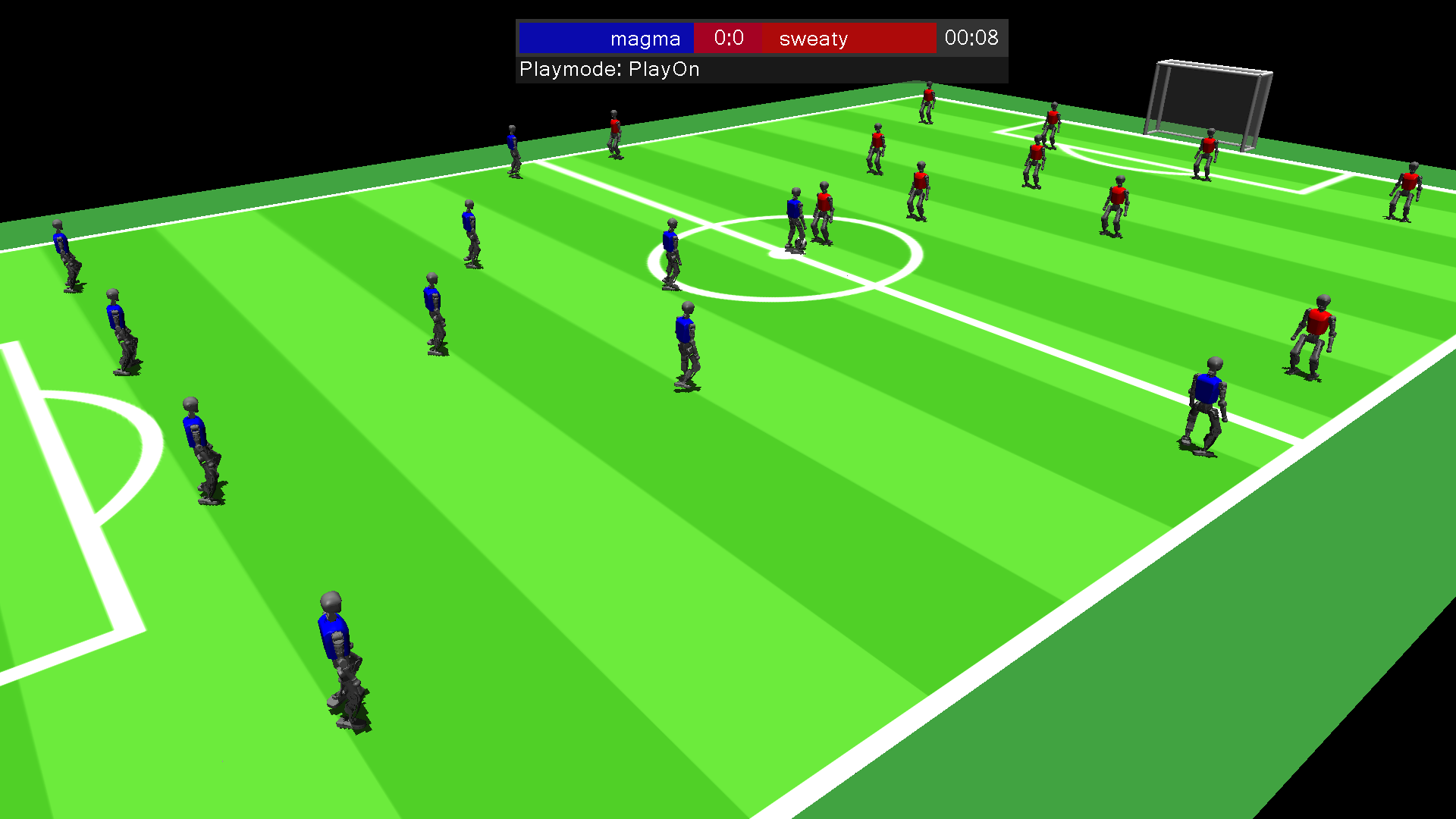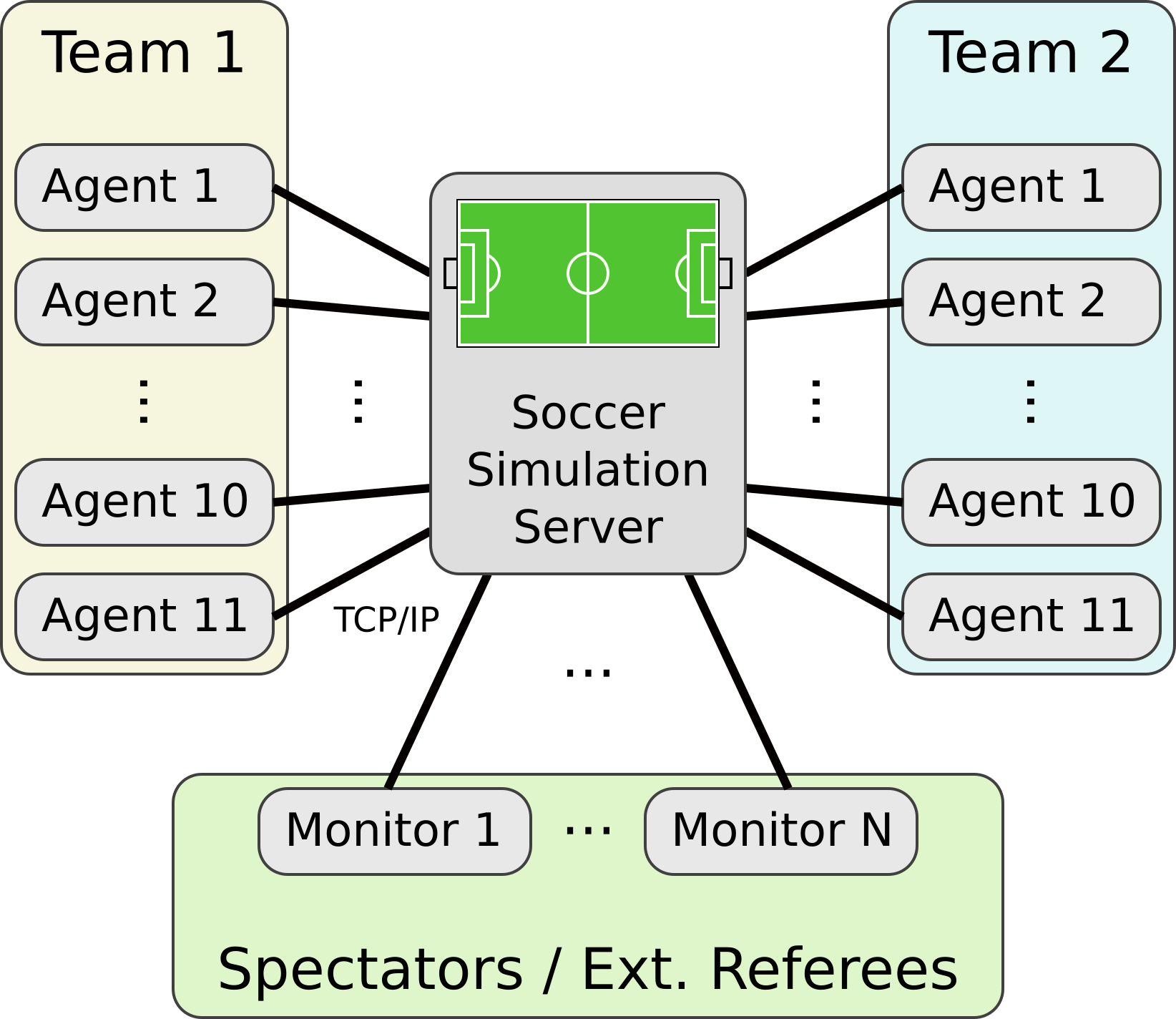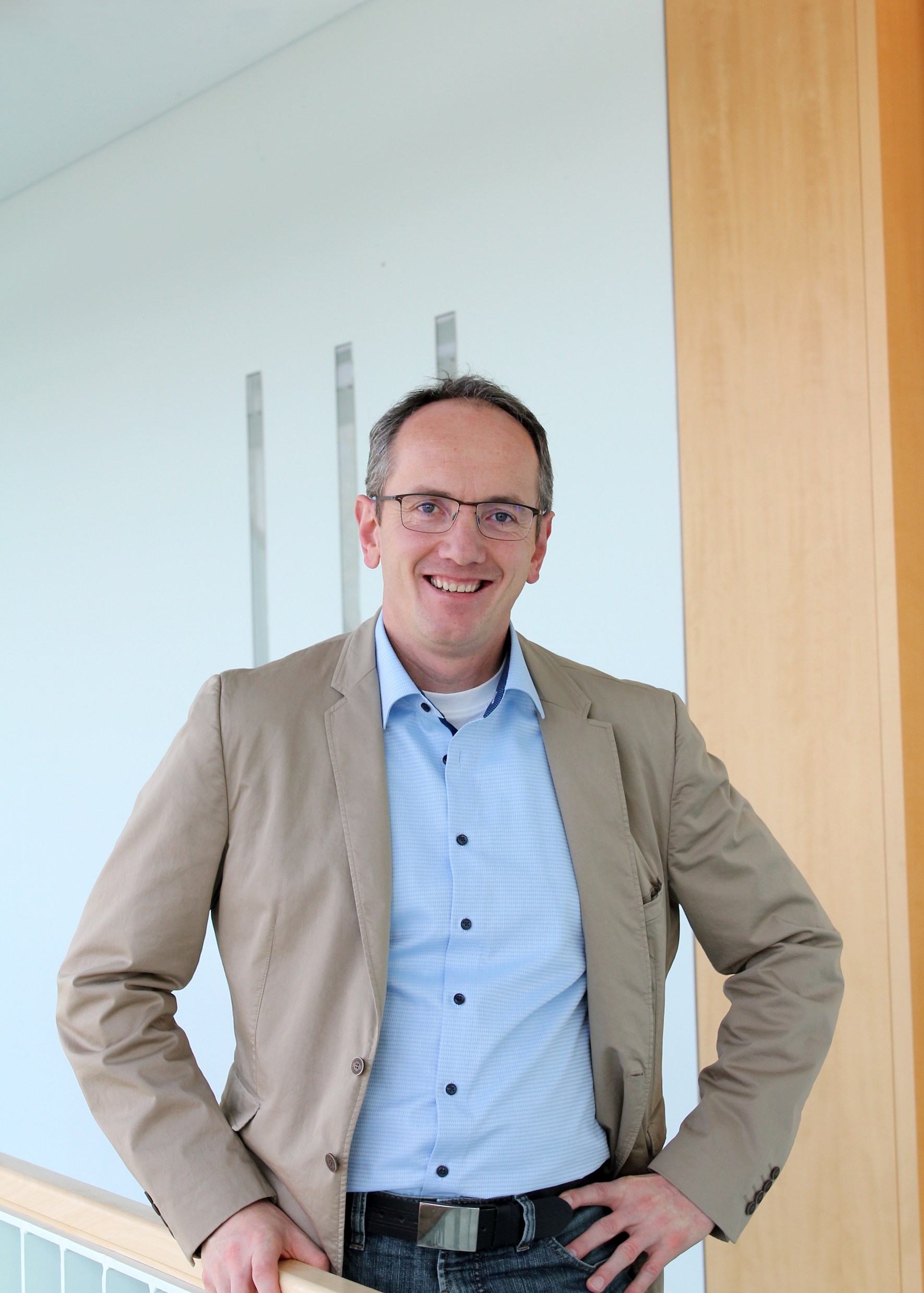 A screenshot from the brand new simulator that can be trialled for a particular problem at RoboCup2025.
A screenshot from the brand new simulator that can be trialled for a particular problem at RoboCup2025.
The annual RoboCup occasion, the place groups collect from throughout the globe to participate in competitions throughout quite a lot of leagues, will this 12 months happen in Brazil, from 15-21 July. Upfront of kick-off, we spoke to 2 members of the RoboCup Soccer 3D Simulation League: Govt Committee Member Klaus Dorer, and Stefan Glaser, who’s on the Upkeep Committee and who has been lately creating a brand new simulator for the League.
May begin by simply giving us a fast introduction to the Simulation League?
Klaus Dorer: There are two Simulation Leagues in Soccer: the 2D Simulation League and the 3D Simulation League. The 2D Simulation League, because the identify suggests, is a flat league the place the gamers and ball are simulated with simplified physics and the principle focus is on crew technique. The 3D Simulation League is way nearer to actual robots; it simulates 11 versus 11 Nao robots. The extent of management is like with actual robots, the place you progress every motor of the legs and the arms and so forth to attain motion.
I perceive that you’ve got been engaged on a brand new simulator for the 3D League. What was the thought behind this new simulator?
Klaus: The purpose is to carry us nearer to the {hardware} leagues in order that the simulator might be extra helpful. The present simulator that we use within the 3D Simulation League known as SimSpark. It was created within the early 2000s with the purpose of creating it potential to play 11 vs 11 gamers. With the {hardware} constraints of that point, there needed to be some compromises on the physics to have the ability to simulate 22 gamers on the similar time. So the simulation is bodily considerably life like, however not within the sense that it’s straightforward to transpose it to an actual Nao robotic.
Stefan Glaser: The concept for creating a brand new simulator has been round for just a few years. SimSpark is a really highly effective simulation framework. The bottom framework is area unbiased (not soccer particular) and particular simulations are realized through plugins. It helps a number of physics engines within the backend and offers a versatile scripting interface for configuration and variations of the simulation. Nonetheless, all this flexibility comes with the worth of complexity. Along with that, SimSpark makes use of customized robotic mannequin specs and communication protocols, limiting the quantity of obtainable robotic fashions and requiring groups to develop customized communication layers just for speaking with SimSpark. On account of this, SimSpark has not been broadly adopted within the RoboCup neighborhood.
With the brand new simulator, I want to handle these two main points: complexity and standardization. Within the ML neighborhood, the MuJoCo physics engine has turn into a very talked-about selection for studying environments after Google DeepMind acquired it and launched it open supply. Its requirements for world and robotic mannequin specs are broadly adopted locally and there exist loads of ready-to-use robotic mannequin specs for all kinds of digital in addition to real-world robots. In the course of final 12 months, they (MuJoCo) added a function which lets you manipulate the world illustration throughout simulation (including and eradicating objects to / from the simulation whereas preserving the simulation state). That is one important requirement we have now within the simulation league, the place we begin with an empty subject after which the brokers join on demand and type the groups. When this function has been added, I made a decision to make a step ahead and attempt to implement a brand new simulator for the 3D Simulation League primarily based on MuJoCo. Initially, I wished to begin improvement in C/C++ to attain most efficiency, however then determined to begin in Python to scale back complexity and make it extra accessible for different builders. I began improvement on Easter Monday so it’s not even three months outdated!
I feel it may be helpful to elucidate slightly bit extra in regards to the setup of our league and the necessities of the simulator. If we take the FIFA recreation (in your favourite gaming gadget) for instance, there may be one simulation occurring which simulates 22 gamers and the choice making is a part of the simulation having full entry to the state of the world. Within the 3D Simulation League we have now two groups with 11 robots on the sector, however we even have 22 particular person agent softwares that are linked to the simulation server, every controlling one single robotic. Every linked agent solely receives sensor data associated to their robotic within the simulation. They’re additionally solely allowed to speak through the server – there isn’t a direct communication between the brokers allowed in Simulation League. So we have now a normal setup the place the simulation server has to have the ability to settle for as much as 22 connections and handle the scenario there. This performance has been the main focus for me for the final couple of months and this half is already working properly. Groups can join their brokers, which can obtain sensor data and might actuate joints of the robotic within the simulation and so forth. They’re additionally capable of choose totally different robotic fashions in the event that they like.
 An illustration of the simulator set-up.
An illustration of the simulator set-up.
Presumably the brand new simulator has a greater illustration of the physics of an actual robotic.
Klaus: Precisely. For instance, how the motors are managed is now a bit totally different and far nearer to actual robots. So once I did my first experiments, I noticed the robotic collapse and I believed it was precisely how an actual robotic would collapse! In SimSpark we additionally had falling robots however the motor management within the new simulator is totally different. Now you’ll be able to management the motors by pace, by power, by place, which is far more versatile – it’s nearer to what we all know from actual robots.
I feel that, not less than initially, it is going to be harder for the Simulation League groups to get the robots to do what they need them to do, as a result of it’s extra life like. For instance, in SimSpark the bottom contact was far more forgiving. So in the event you step arduous on the bottom, you don’t fall instantly with a SimSpark robotic however with a MuJoCo robotic this can be far more life like. Certainly, in actual robots floor contact is considerably much less forgiving.
I had a query in regards to the imaginative and prescient facet – how do the person brokers “see” the place of the opposite brokers on the sector?
Stefan: We simulate a digital imaginative and prescient pipeline on the server facet. You might have a restricted subject of view of ±60° horizontally and vertically. Inside that subject of view you’ll detect the pinnacle, the arms, the toes of different gamers, or the ball, for instance, or totally different options of the sector. Much like frequent real-world imaginative and prescient pipelines, every detection consists of a label, a path vector and the gap data. The knowledge has some noise on it like actual robots have, too, however groups don’t must course of digital camera pictures. They get the detections instantly from the simulation server.
We’ve beforehand had a dialogue about shifting in the direction of getting digital camera pictures of the simulation to combine into the imaginative and prescient pipeline on the agent facet. This was by no means actually life like in SimSpark with the implementation we had there. Nonetheless, it must be potential with MuJoCo. Nonetheless, for the primary model, I used the identical manner the standard simulator handled the imaginative and prescient. Because of this groups don’t want to coach a imaginative and prescient mannequin, and don’t must deal with digital camera pictures to get began. This reduces the load considerably and likewise shifts the main focus of the issue in the direction of movement and resolution making.
Will the simulator be used at RoboCup 2025?
Stefan: We plan to have a problem with a brand new simulator and I’ll attempt to present some demo video games. In the intervening time it’s not likely in a state the place you’ll be able to play a complete competitors.
Klaus: That’s normally how we proceed with new simulators. We’d not transfer from one to the opposite with none intermediate step. We could have a problem this 12 months at RoboCup 2025 with the brand new MuJoCo simulator the place every taking part crew will attempt to train the robotic to kick so far as potential. So, we is not going to be enjoying a complete recreation, we received’t have a number of robots, only a single robotic stepping in entrance of the ball and kicking the ball. That’s the technical problem for this 12 months. Groups will get an concept of how the simulator works, and we’ll get an concept of what needs to be modified within the simulator to proceed.
This new problem can be voluntary, so we’re not positive what number of groups will take part. Our crew (MagmaOffenburg) will definitely participate. Will probably be attention-grabbing to see how properly the groups carry out as a result of nobody is aware of how far kick is on this simulator. It’s a bit like in Components One when the principles change and nobody is aware of which crew would be the main crew.
Do you’ve got an concept of how a lot adaptation groups should make if and if you transfer to the brand new simulator for the complete matches?
Stefan: As a long-term member of 3D Simulation League, I do know the outdated simulator SimSpark fairly properly, and know the protocols concerned and the way the processes work. So the primary model of the brand new simulator is designed to make use of the identical fundamental protocol, the identical sensor data, and so forth. The concept is that the groups can use the brand new simulator with minimal effort in adapting their present agent software program. So they need to be capable to get began fairly quick.
Though, when designing a brand new platform, I want to take the chance to make a step ahead by way of protocols, as a result of I additionally need to combine different Leagues within the long-term. They normally produce other management mechanisms, and so they don’t use the identical protocol that’s outstanding in 3D Simulation. Due to this fact there needs to be some flexibility sooner or later. However for the primary model, the thought was to get the Simulation League prepared with minimal effort.
Klaus: The massive concept is that this isn’t simply used within the 3D Simulation league, but in addition as a helpful simulator for the Humanoid League and likewise for the Normal Platform League (SPL). So if that seems to be true, then it is going to be fully profitable. For the Kick Problem this 12 months, for instance, we use a T1 robotic that could be a Humanoid League robotic.
May you say one thing about this simulation to actual world (Sim2Real) facet?
Stefan: We’d prefer it to be potential for the motions and behaviors within the simulator to be ported to actual robots. From my perspective, it might be helpful the opposite manner spherical too.
We, as a Simulation League, normally develop for the Simulation League and subsequently want to get the behaviors working on an actual robotic. However the {hardware} groups normally have an analogous challenge once they need to check high-level resolution making. They could have two to 5 robots on the sector, and in the event that they need to play a high-level decision-making match and prepare in that regard, they all the time should deploy loads of robots. If in addition they need to have an opponent, they should double the quantity of robots in an effort to play a recreation to see how the technique would prove. The Sim2Real facet can be attention-grabbing for these groups, as a result of they need to be capable to take what they deployed on the true robotic and it also needs to work within the simulation. They will then use the simulation to coach high-level expertise like crew play, participant positioning and so forth, which is a difficult facet for the true robotic leagues like SPL or the Humanoid Leagues.
Klaus: And the explanation we all know it’s because we have now a crew within the Simulation League and we have now a crew within the Humanoid League. In order that’s one more reason why we’re eager to carry these items nearer collectively.
How does the refereeing work within the Simulation League?
Klaus: A pleasant factor about Simulation Leagues is that there’s a program which is aware of the true state of the world so we are able to construct within the referee contained in the simulator and it’ll not fail. For issues like offside, whether or not the ball handed the objective line, that’s fail secure. All of the referee selections are taken by the system itself. We have now a human referee however they by no means must intervene. Nonetheless, there are conditions the place we wish synthetic intelligence to play a job. This isn’t at present the case in SimSpark as a result of the principles are all arduous coded. We have now loads of fouls which might be debatable. For instance, there are lots of fouls that groups agree shouldn’t have been a foul, and different fouls that aren’t referred to as that ought to have been. It could be a pleasant AI studying process to get some conditions judged by human referees after which prepare an AI mannequin to raised decide the principles for what’s a foul and what isn’t a foul. However that is at present not the case.
Stefan: On the brand new simulator I’m not that far into the event that I’ve carried out the automated referee but. I’ve some fundamental algorithm which progress the sport as such, however judging fouls and deciding on particular conditions will not be but carried out within the new simulator.
What are the following steps for creating the simulator?
Stefan: One of many subsequent main steps can be to refine the physics simulation. As an example, although there exists a ball within the simulation, it’s not but very well refined. There are loads of physics parameters which we have now to determine on to mirror the true world pretty much as good as potential. This may doubtless require a sequence of experiments in an effort to get to the right values for varied facets. On this facet I’m hoping for some engagement of the neighborhood, as it’s a nice analysis alternative and I personally would favor the neighborhood to determine on a generally accepted parameter set primarily based on a degree of proof that I can’t simply present all on my own. So in case somebody is eager about refining the physics of the simulation such that it finest displays the true world, you might be welcome to hitch!
One other main subsequent step would be the improvement of the automated referee of the soccer simulation, deciding on fouls, dealing with misbehaving brokers and so forth. Within the first model, foul situations will doubtless be judged by an knowledgeable system particularly designed for this function. The simulation league has developed a set of foul situation specs which I plan to adapt. In a second step, I want to combine and assist the event of AI primarily based foul detection fashions. However yeah, one step after the opposite.
What are you significantly trying ahead to at RoboCup2025?
Klaus: Nicely, with our crew we have now been vice world champion seven occasions in a row. This 12 months we’re actually hoping to make it to world champion. We’re very skilled in getting losses in finals and this 12 months we’re trying ahead to altering that, from a crew perspective.
Stefan: I’m going to Brazil in an effort to promote the simulator, not only for the Simulation League, but in addition throughout the boundaries for the Humanoid Leagues and the SPL Leagues. I feel that this simulator is a good probability to carry individuals from all of the leagues collectively. I’m significantly within the particular necessities of all of the groups of the totally different leagues. This understanding will assist me tailor the brand new simulator in the direction of their wants. That is certainly one of my main highlights for this 12 months, I might say.
You will discover out extra in regards to the new simulator on the undertaking webpage, and from the documentation.

|
Klaus Dorer is professor for synthetic intelligence, autonomous methods and software program engineering at Offenburg College, Germany. He’s additionally a member of the Institute for Machine Studying and Analytics IMLA. He has been crew chief of the RoboCup simulation league groups magmaFreiburg (since 1999), dwelling methods, magmaFurtwangen and is now crew chief of magmaOffenburg since 2009. Since 2014, he has additionally been a part of the humanoid grownup measurement league crew Sweaty. |

|
Stefan Glaser is educating assistant for synthetic intelligence and clever autonomous methods on the Offenburg College, Germany. He has been a part of the RoboCup simulation league crew magmaOffenburg since 2009 and the RoboCup humanoid grownup measurement league crew Sweaty since 2014. |
AIhub
is a non-profit devoted to connecting the AI neighborhood to the general public by offering free, high-quality data in AI.

AIhub
is a non-profit devoted to connecting the AI neighborhood to the general public by offering free, high-quality data in AI.

Lucy Smith
is Managing Editor for AIhub.



